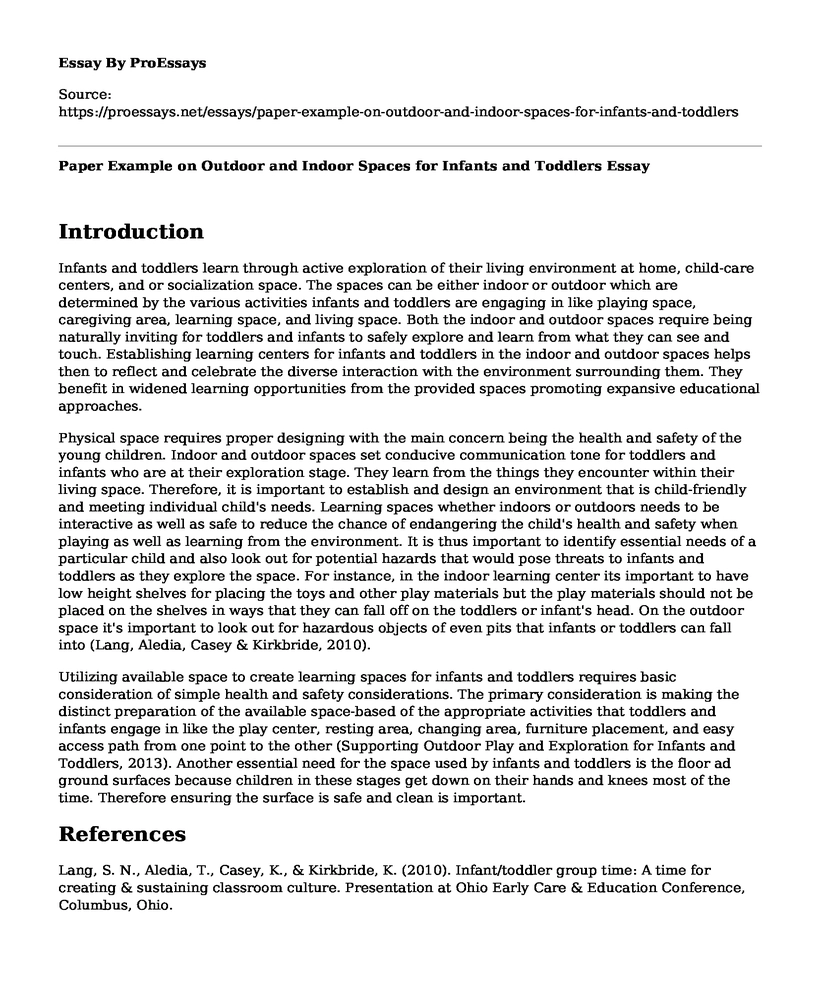Introduction
Infants and toddlers learn through active exploration of their living environment at home, child-care centers, and or socialization space. The spaces can be either indoor or outdoor which are determined by the various activities infants and toddlers are engaging in like playing space, caregiving area, learning space, and living space. Both the indoor and outdoor spaces require being naturally inviting for toddlers and infants to safely explore and learn from what they can see and touch. Establishing learning centers for infants and toddlers in the indoor and outdoor spaces helps then to reflect and celebrate the diverse interaction with the environment surrounding them. They benefit in widened learning opportunities from the provided spaces promoting expansive educational approaches.
Physical space requires proper designing with the main concern being the health and safety of the young children. Indoor and outdoor spaces set conducive communication tone for toddlers and infants who are at their exploration stage. They learn from the things they encounter within their living space. Therefore, it is important to establish and design an environment that is child-friendly and meeting individual child's needs. Learning spaces whether indoors or outdoors needs to be interactive as well as safe to reduce the chance of endangering the child's health and safety when playing as well as learning from the environment. It is thus important to identify essential needs of a particular child and also look out for potential hazards that would pose threats to infants and toddlers as they explore the space. For instance, in the indoor learning center its important to have low height shelves for placing the toys and other play materials but the play materials should not be placed on the shelves in ways that they can fall off on the toddlers or infant's head. On the outdoor space it's important to look out for hazardous objects of even pits that infants or toddlers can fall into (Lang, Aledia, Casey & Kirkbride, 2010).
Utilizing available space to create learning spaces for infants and toddlers requires basic consideration of simple health and safety considerations. The primary consideration is making the distinct preparation of the available space-based of the appropriate activities that toddlers and infants engage in like the play center, resting area, changing area, furniture placement, and easy access path from one point to the other (Supporting Outdoor Play and Exploration for Infants and Toddlers, 2013). Another essential need for the space used by infants and toddlers is the floor ad ground surfaces because children in these stages get down on their hands and knees most of the time. Therefore ensuring the surface is safe and clean is important.
References
Lang, S. N., Aledia, T., Casey, K., & Kirkbride, K. (2010). Infant/toddler group time: A time for creating & sustaining classroom culture. Presentation at Ohio Early Care & Education Conference, Columbus, Ohio.
Supporting Outdoor Play and Exploration for Infants and Toddlers. (2013). Early Head Start National Resource Center. Retrieved from http://eclkc.ohs.acf.hhs.gov/hslc/tta-system/ehsnrc/docs/ehs-ta-paper-14-outdoor-play.pdf
Cite this page
Paper Example on Outdoor and Indoor Spaces for Infants and Toddlers. (2022, Jun 05). Retrieved from https://proessays.net/essays/paper-example-on-outdoor-and-indoor-spaces-for-infants-and-toddlers
If you are the original author of this essay and no longer wish to have it published on the ProEssays website, please click below to request its removal:
- The Fatal Surfing Incident
- Translating a Poem: Der Fichtenbaum und die Palme by Heinrich Heine
- Paper Example on Mathematics Teaching
- Essay Sample on Child Labor
- Essay Example on Overcoming Exam Stress: Strategies to Reduce Test Anxiety
- Historical Analysis of English Learning: Rooting & Development - Essay Sample
- Free Essay Example on Thorndike's Law of Effect: Stimuli-Response & Reinforcement







